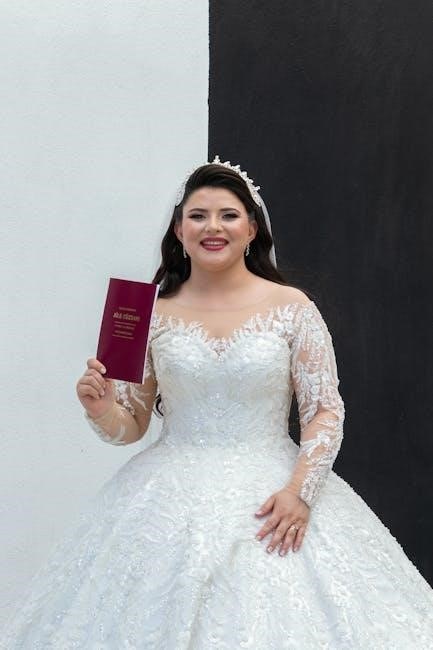An affidavit of bona fide marriage is a sworn declaration proving the legitimacy of a marital relationship, often required for immigration purposes. It provides detailed, truthful information about the marriage, including how the couple met, their relationship history, and joint responsibilities. This document is essential for demonstrating that the marriage is genuine and not entered into solely for legal benefits. Using a sample PDF can guide individuals in drafting a clear and precise affidavit, ensuring compliance with legal standards and avoiding common mistakes.
1.1 Purpose of the Affidavit
The primary purpose of an affidavit of bona fide marriage is to provide a sworn declaration that a marital relationship is genuine and legitimate. It is often required in immigration proceedings to prove that the marriage was not entered into solely for legal benefits. The affidavit serves as a formal statement detailing the history of the relationship, how the couple met, and evidence of their commitment to one another. By submitting this document, the couple demonstrates that their marriage is based on mutual intent and bona fide intentions, rather than fraud or convenience. This is a critical step in establishing the authenticity of the relationship for legal purposes.
1.2 Key Elements of a Bona Fide Marriage
A bona fide marriage is characterized by several key elements that distinguish it from other types of marriages. First and foremost, it must be entered into in good faith, with both parties intending to establish a life together. This is opposed to marriages of convenience, which are solely for legal benefits. Additionally, the couple must share mutual commitment and responsibilities, such as joint financial obligations, cohabitation, and emotional support. The marital relationship should also be recognized socially, with evidence such as photographs, joint accounts, and public acknowledgment. These elements collectively demonstrate that the marriage is genuine and not fraudulent in nature.
1.3 Importance of Using a Sample PDF
Using a sample PDF for an affidavit of bona fide marriage is crucial for ensuring accuracy and compliance with legal requirements. A sample provides a clear structure and format, guiding individuals on how to present their information effectively. It helps avoid common mistakes, such as omitting essential details or using vague language, which can lead to delays or rejection. By following a reliable template, users can ensure their affidavit meets the necessary legal standards, improving the likelihood of a successful submission. Additionally, a sample PDF saves time and reduces confusion, making the process of drafting the affidavit more efficient and straightforward.
Understanding Bona Fide Marriage
A bona fide marriage is a genuine marital relationship entered into with the intent to establish a life together, not solely for legal or financial gain. It requires mutual commitment, shared responsibilities, and a legitimate emotional bond between the couple. Understanding this concept is crucial for immigration purposes, as it distinguishes valid unions from fraudulent ones. The relationship must be proven through evidence, such as joint financial accounts, shared living arrangements, and testimonials from witnesses. This legal recognition ensures the marriage is authentic and meets the criteria for immigration benefits.
2.1 Definition and Legal Implications
A bona fide marriage is a legitimate, genuine marital relationship entered into with the intent to establish a life together, not solely for legal or financial gain. It requires mutual commitment, shared responsibilities, and a legitimate emotional bond between the couple. Legally, it distinguishes valid unions from fraudulent ones, ensuring the marriage meets immigration criteria. The affidavit serves as a sworn declaration, providing evidence of the relationship’s authenticity. Its accuracy is crucial, as false statements can lead to legal consequences. Understanding this definition is essential for immigration proceedings, as it directly impacts the validity of visa applications and residency status.
2.2 Differences from Other Types of Marriages
Bona fide marriages differ from other types of marriages in their intent and legal recognition. Unlike sham marriages, which are entered into for immigration benefits or financial gain, bona fide marriages are based on genuine emotional commitment and mutual intent to build a life together. They are distinct from common-law or proxy marriages, which may lack formal documentation or personal cohabitation. The legal implications of bona fide marriages are significant, as they are recognized by immigration authorities and courts, ensuring rights and benefits for both spouses. This distinction is crucial for verifying the authenticity of marital relationships in legal proceedings.
2.3 Requirements for Proving a Bona Fide Marriage
To prove a bona fide marriage, couples must provide evidence demonstrating their relationship’s legitimacy. This includes submitting joint financial records, such as bank statements and tax filings, showing shared financial responsibilities. Photographs from weddings, vacations, and daily life can illustrate the relationship’s continuity. Testimonies from friends and family, along with correspondence like letters and emails, further substantiate the marriage’s authenticity. Legal documents, such as property deeds or leases in both names, also serve as proof. The affidavit itself must be notarized and include detailed, specific information about the relationship’s history and ongoing commitment, ensuring compliance with legal standards and avoiding vague or generic statements.

Legal Requirements for the Affidavit
The affidavit must be notarized, signed under penalty of perjury, and include specific details about the marriage, such as how the couple met and their shared life.
3.1 Necessary Information to Include
The affidavit must include the full names, dates of birth, and citizenship details of both spouses. It should describe how and where the couple met, their relationship history, and joint responsibilities. The document should outline the date and place of marriage, cohabitation details, and shared financial commitments. Personal knowledge of the marital relationship, such as joint assets, shared household duties, and mutual responsibilities, should be explicitly stated. Photographic evidence of the couple together and with family and friends can also be included. The affidavit must be notarized, containing the affiant’s signature and a notary seal to ensure authenticity and compliance with legal standards.
3.2 Supporting Documentation and Evidence
Include marriage certificates, joint financial records, property deeds, and photographs of the couple together. Correspondence, such as letters or emails, can demonstrate ongoing communication. Joint bank statements, tax filings, and insurance policies provide evidence of financial unity. Affidavits from third parties, like family or friends, can corroborate the relationship. Documentation of shared responsibilities, such as utility bills or lease agreements, strengthens the case. All evidence should be clearly labeled and attached to the affidavit. Ensuring these documents are organized and relevant helps establish the legitimacy of the marriage. This supporting evidence is crucial for substantiating the claims made in the affidavit.
3.3 Legal Standards for Authenticity
The affidavit must meet strict legal standards to ensure authenticity. It should be notarized, with the affiant’s signature witnessed by a certified notary public. The document must be signed under penalty of perjury, affirming the truthfulness of the statements. Clarity and precision in language are essential to avoid ambiguity. The affidavit should comply with jurisdictional requirements, such as formatting and content specifications. Supporting evidence, like marriage certificates or joint financial records, must be attached and verified. Adherence to these standards ensures the affidavit is credible and legally admissible. Failure to meet these standards can result in the document being rejected or deemed invalid in legal proceedings.
Key Elements of the Affidavit Document
The affidavit must include the affiant’s full details, a clear statement of the marital relationship, and specific examples of joint commitments. Using a sample PDF ensures proper structure and compliance with legal requirements, helping to avoid errors and omissions. The document should be concise, yet detailed, to establish credibility and authenticity effectively.
4.1 Structure and Format
The affidavit of bona fide marriage must follow a specific structure to ensure clarity and legality. It should begin with a heading stating the document’s purpose, followed by the affiant’s personal information, such as name, address, and relationship to the couple. The body should include a sworn statement detailing the marriage’s legitimacy, with specific examples of the couple’s joint commitments and shared life. The document should conclude with a declaration of truthfulness, witness signatures if required, and a notary seal. Using a sample PDF ensures the correct format is maintained, with clear sections for each piece of information, guaranteeing compliance with legal standards and avoiding errors. Proper formatting enhances credibility and ensures the affidavit is taken seriously by authorities.
4.2 Essential Clauses and Statements
An affidavit of bona fide marriage must include specific clauses and statements to validate its legitimacy. Key elements include a declaration of the couple’s lawful marriage, details of how they met, and evidence of their shared life, such as joint financial responsibilities or cohabitation. Statements affirming the absence of legal impediments to the marriage and the genuineness of the relationship are crucial. The affidavit should also outline the affiant’s personal knowledge of the couple’s interactions and commitment to each other. Including explicit examples, such as shared events or mutual support, strengthens the document. Clarity and detail are essential to avoid ambiguity and ensure the affidavit meets legal standards for authenticity and admissibility.
4.3 Role of Witnesses and Signatures
The affidavit of bona fide marriage requires the signatures of the affiant and, in some cases, witnesses. Witnesses must have personal knowledge of the couple’s relationship and can attest to its legitimacy. Their signatures add credibility to the document. The affiant, typically a neutral third party, must sign the affidavit in the presence of a notary public to ensure authenticity. Notarization is a critical step, as it verifies the identity of the signer and the voluntary nature of the statement. Proper signatures and notarization ensure the affidavit is legally binding and admissible in immigration or legal proceedings. This formal process safeguards the document’s integrity and validity.

Process of Creating the Affidavit
Creating the affidavit involves gathering information, drafting the document, and finalizing it with precise details. Using a sample PDF provides a structured template for customization with specific evidence and statements, ensuring clarity and completeness in the marital relationship documentation. This step-by-step approach helps in organizing the content effectively while adhering to legal standards, making the process systematic and efficient for the user.
5.1 Gathering Necessary Information
Gathering necessary information is the first step in creating an affidavit of bona fide marriage. This includes details about how the couple met, their relationship timeline, and shared responsibilities. Collecting evidence such as joint documents, photographs, and witness statements is crucial. Personal knowledge of the couple’s interactions and milestones should be documented. Ensuring accuracy and specificity in the information gathered is vital to establish the legitimacy of the marriage. Organizing these details systematically helps in drafting a coherent and credible affidavit, aligning with legal requirements and avoiding potential discrepancies.

5.2 Drafting the Affidavit
Drafting the affidavit involves structuring the gathered information into a clear, concise, and legally binding document. Begin with the affiant’s personal details, followed by a statement of their relationship to the couple. Clearly outline the couple’s relationship history, including how they met, significant events, and shared responsibilities. Specify examples of joint activities, financial commitments, and mutual support. Avoid generic statements; instead, use precise and factual language. Include details about cohabitation, if applicable, and attach supporting evidence. Ensure the affidavit is written in a formal tone and adheres to legal standards. Using a sample PDF as a template can help maintain the correct format and structure.
5.3 Review and Finalization
After drafting, carefully review the affidavit for accuracy, completeness, and clarity. Ensure all statements are truthful and supported by evidence. Check for grammatical errors and consistency in dates, names, and details. Verify that all required sections are filled out and that the document adheres to legal standards. Compare it with a sample PDF to ensure proper formatting and structure. Once satisfied, sign the affidavit in the presence of a notary public, who will authenticate the document. This step is crucial for the affidavit’s validity and admissibility in legal proceedings. Keep a copy for personal records and submit the original as required.
Common Mistakes to Avoid
Avoid generic or vague statements, as they may undermine credibility. Ensure all claims are specific and supported by evidence. Omitting key details or providing false information can lead to legal repercussions and delays in immigration processes.
6.1 Avoiding Generic or Vague Statements
Generic or vague statements can weaken the credibility of an affidavit of bona fide marriage. It is crucial to provide specific details about the relationship, such as how and where the couple met, the progression of their relationship, and shared experiences. Including dates, locations, and personal anecdotes adds authenticity. Avoid broad claims like “we love each other” without supporting evidence. Instead, focus on concrete examples, such as joint financial decisions, shared responsibilities, or mutual goals. This specificity helps demonstrate the genuine nature of the marriage and aligns with legal requirements for immigration purposes.
6.2 Ensuring Compliance with Legal Standards
Ensuring compliance with legal standards is critical when drafting an affidavit of bona fide marriage. The document must adhere to specific requirements, such as including the affiant’s full name, address, and relationship to the couple. It should be notarized to verify authenticity and signed in the presence of a witness. Additionally, the affidavit must avoid false statements, as these can lead to severe legal consequences, including perjury charges. Using a sample PDF from a reliable source can help ensure the document meets all necessary legal criteria. Proper formatting, clear language, and inclusion of supporting evidence are also essential to maintain its validity in legal proceedings.
Using a Sample PDF for Guidance
A sample PDF provides a structured template, ensuring clarity and inclusion of necessary details like the couple’s relationship history and joint responsibilities.
7.1 Benefits of Using a Sample Template

Using a sample PDF template for an affidavit of bona fide marriage offers numerous advantages. It provides a clear structure, ensuring all necessary sections are included, such as relationship history and joint responsibilities. Templates guide users to avoid omissions and ensure compliance with legal standards. They also save time by eliminating the need to draft the document from scratch. Additionally, sample templates reduce the risk of errors, helping to present a credible and professional affidavit. This is particularly beneficial for individuals unfamiliar with legal documentation, as it streamlines the process and increases the likelihood of approval.
7.2 Where to Find Reliable Templates Online
Reliable templates for an affidavit of bona fide marriage can be found on trusted legal websites and platforms. Sites like USCIS.gov and legal document providers offer verified samples. Additionally, law firm websites and online legal forums often provide downloadable PDF templates. It’s crucial to ensure the template is specific to your needs, such as immigration purposes. Always verify the source’s credibility to avoid using outdated or incorrect formats. Using a template from a reputable source ensures the document meets legal standards and improves the chances of a successful submission.

Including Supporting Documentation
Supporting documents validate the marital relationship, including marriage certificates, joint financial records, photographs, and witness statements. These materials strengthen the affidavit’s credibility and demonstrate the marriage’s authenticity.
8.1 Types of Documents to Include
When preparing an affidavit of bona fide marriage, include documents that substantiate the relationship, such as marriage certificates, joint bank statements, utility bills, and leases. Photographs of the couple together at various events and with family and friends provide visual evidence. Correspondence, like emails or letters, and social media messages can demonstrate ongoing communication. Joint financial records, such as tax returns or insurance policies, show shared responsibilities. Witness statements from friends or relatives who can attest to the relationship’s legitimacy are also valuable. These documents collectively validate the marriage’s authenticity and strengthen the affidavit’s credibility.
8.2 Organizing and Presenting Evidence
Organizing evidence in an affidavit of bona fide marriage requires a structured approach to ensure clarity and coherence. Begin by categorizing documents into sections, such as financial records, correspondence, and photographs. Use clear headings and dates to make the information easily accessible. Attach each document securely and reference it appropriately within the affidavit. Include a table of contents or index to guide reviewers through the evidence. Presenting evidence in a logical and chronological order strengthens the credibility of the affidavit. Ensure all documents are legible, translated if necessary, and comply with legal requirements to avoid delays in processing.

Role of the Affiant
The affiant must provide a credible, notarized statement based on personal knowledge of the couple, supporting the legitimacy of their relationship and the bona fide marriage.
9.1 Who Can Serve as an Affiant
An affiant must be a credible individual with personal knowledge of the couple’s relationship, such as a family member, friend, or colleague. They must be at least 18 years old, of sound mind, and willing to testify under oath. The affiant should not have a conflict of interest or direct involvement in the immigration process. Their role is to provide an objective, truthful account of the marriage’s legitimacy, supporting the couple’s claims. The affiant’s statement is typically notarized to ensure authenticity, making it admissible in legal proceedings. Their credibility enhances the overall persuasiveness of the affidavit.
9.2 Testimony and Credibility in the Affidavit
The affiant’s testimony must be based on personal knowledge of the couple’s relationship, providing specific examples of interactions, shared responsibilities, and joint activities. Credibility is crucial, as the affiant’s statement is often scrutinized by legal authorities. The testimony should avoid vague or generic statements, instead offering detailed, factual accounts that substantiate the marriage’s legitimacy. The affiant’s reputation and honesty also impact the affidavit’s persuasiveness. Notarization ensures the affiant’s statements are made under oath, adding legal weight. Any discrepancies or falsehoods can undermine the affidavit’s credibility and potentially jeopardize the immigration process, emphasizing the importance of truthful and accurate testimony.
Best Practices for Drafting the Affidavit
Use clear, precise language, and include specific examples to support claims. Consult an attorney to ensure accuracy and compliance. Always use a sample PDF for guidance and include detailed evidence to strengthen credibility.
10.1 Clarity and Precision in Language
Clarity and precision are crucial when drafting an affidavit of bona fide marriage. Vague statements can lead to misunderstandings or delays. Use specific dates, events, and examples to illustrate the marital relationship. Avoid overly broad or generic claims, as they may lack credibility. Instead, include detailed anecdotes, such as how the couple met, shared responsibilities, and significant life events. This approach strengthens the affidavit’s persuasiveness and demonstrates the marriage’s authenticity. Referencing a sample PDF can help ensure language is clear and structured effectively. Ambiguity in the affidavit can result in legal challenges or requests for additional evidence, so precision is essential to avoid complications.
10.2 Ensuring the Document is Notarized
Notarizing the affidavit of bona fide marriage is essential to validate its authenticity. A notary public verifies the affiant’s identity and confirms that the signature was made voluntarily. This step ensures the document’s credibility and admissibility in legal proceedings. To notarize, the affiant must appear before a notary with proper identification and sign the affidavit in their presence. The notary then stamps or seals the document, confirming its legitimacy. Failing to notarize the affidavit can render it invalid, delaying or complicating legal processes. Always ensure the notarization process is completed accurately to maintain the document’s legal standing and avoid potential issues. This step is non-negotiable for compliance.

Legal Implications of the Affidavit
The affidavit of bona fide marriage carries significant legal weight, as false statements can lead to severe consequences, including perjury charges and immigration denials. Its admissibility in court relies on its authenticity and compliance with legal standards, making it a critical document in immigration proceedings.
11.1 Consequences of False Statements
Falsifying an affidavit of bona fide marriage can result in severe legal repercussions. Perjury charges may be filed, leading to criminal penalties, including fines and imprisonment. Additionally, immigration authorities may deny visa applications or revoke existing statuses, jeopardizing the petitioner’s legal standing. Misrepresentation can also irreparably damage credibility, affecting future legal proceedings. It is crucial to ensure all information provided is truthful and accurate to avoid these consequences and maintain the integrity of the legal process. The affidavit’s authenticity is paramount, as any falsehood can undermine the entire case and lead to long-term immigration complications.
11.2 Admissibility in Legal Proceedings
An affidavit of bona fide marriage is generally admissible in legal proceedings if it meets specific requirements. The document must be notarized, signed under oath, and based on the affiant’s personal knowledge. Courts typically accept such affidavits as evidence, provided they are free from bias and contain factual, detailed information. However, admissibility may be challenged if the affidavit appears self-serving or lacks specificity. Properly drafted affidavits, supported by credible evidence like marriage certificates, joint financial records, and witness statements, are more likely to be accepted. Their admissibility strengthens the case, ensuring the marital relationship is recognized as legitimate in legal forums.

An affidavit of bona fide marriage is a critical document for verifying marital legitimacy, especially in immigration cases. Using a sample PDF ensures accuracy and compliance with legal standards, helping to establish credibility and avoid potential issues. Proper preparation and adherence to guidelines are essential for a successful submission.
12.1 Summary of Key Points
An affidavit of bona fide marriage is a sworn declaration confirming the legitimacy of a marital relationship, often required for immigration purposes. It must include specific details about the couple’s relationship, such as how they met, shared responsibilities, and joint activities. Supporting documents like photos, joint accounts, and witness statements enhance credibility. Using a sample PDF template ensures compliance with legal standards and helps avoid errors. The affidavit must be truthful, as false statements carry legal consequences. Proper preparation and adherence to guidelines are crucial for a successful submission. This document plays a vital role in demonstrating the authenticity of the marriage, supporting immigration applications effectively.
12.2 Additional Resources for Further Assistance

For further guidance, individuals can access sample PDF templates and detailed instructions on official immigration websites, such as USCIS.gov. Legal platforms like LegalZoom and Nolo offer customizable templates and step-by-step guides. Additionally, consulting with immigration attorneys or legal aid services can provide personalized assistance. Online forums and communities dedicated to immigration issues often share valuable insights and examples. Utilizing these resources ensures that the affidavit is properly drafted and meets all legal requirements. Leveraging these tools helps individuals prepare a compelling and accurate affidavit, increasing the likelihood of a successful application.





